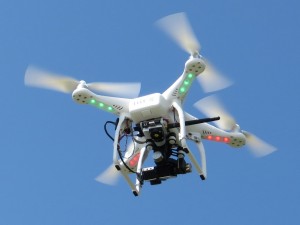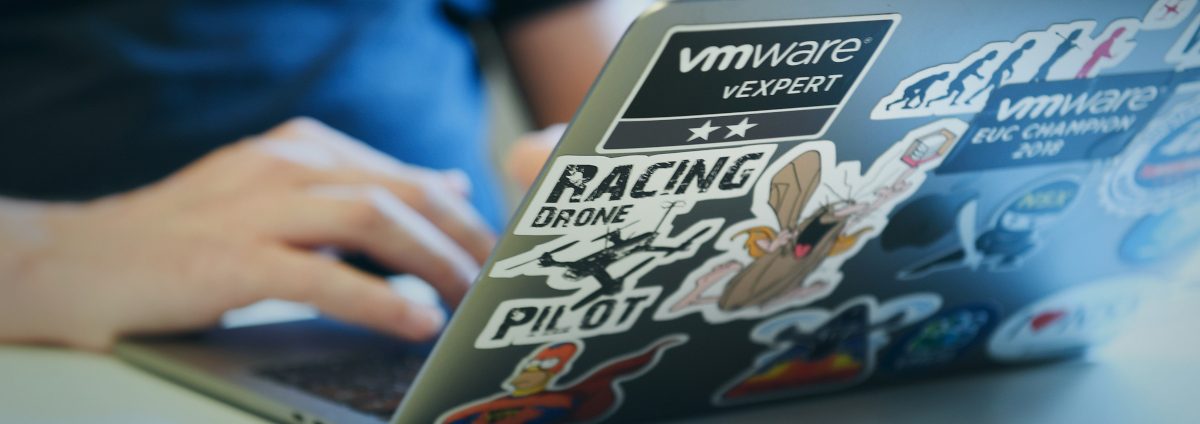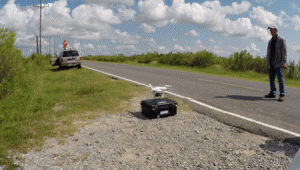When was the last time you had fun doing field research? What’s that you say? Not ever? Then you probably haven’t tried using a quadcopter yet.
A quadcopter is a remotely-operated, miniature helicopter that is lifted and propelled by four rotors. These unmanned aerial vehicles (UAVs), commonly called “drones”, can carry high-definition cameras that are able to capture spectacular aerial video at a fraction of the cost of a full-sized helicopter rental. Quadcopters are increasingly used by business owners such as sports photographers, wildlife photographers, hunters (feral pig spotting), travel agents, and real estate agents (although commercial use of these aircraft was ruled illegal by the FAA in the US). Scientists are just getting started finding ways to use UAVs in field research such as these agriculture researchers.
Last week, I had an opportunity to go out with some colleagues who were testing one, specifically a Phantom II sold by DJI. As you will see in the video, my colleagues are using the quadcopter to acquire low-altitude video of some coastal ecosystems, which can often be remote and/or difficult to traverse on foot.
I drove with two colleagues to Golden Meadow, Louisiana where we met Dr. Mark Byrnes of Applied Coastal Research and Engineering and his son Dylan, who is the expert at piloting their quadcopter. This group has been studying some of the salt marshes in south Louisiana and want to use the quadcopter to assess vegetative recovery from disturbance as well as changes in the geomorphology of the shorelines. We convened for dinner at a local restaurant and discussed the plan for the following day. After sampling the local cuisine (grilled shrimp and sweet potato fries for me), we headed to the hotel where we fired up the quadcopter in the hotel parking lot to check that all systems were functioning properly. Dylan flew the quadcopter, with its lights flashing red and green, around the hotel and periodically up to a couple hundred feet overhead. Before long, we had drawn a crowd of hotel employees and guests. The next morning, we drove to where the study site was located and spent several hours flying the Phantom II around the area. The main objective was to get an idea of how the quadcopter would perform and to begin working out a survey protocol to use on future field trips.
Here’s a video showing some of the highlights:
The following is a more detailed description of the Phantom II that we tested and how it performed.

Description. The Phantom II is a radio-controlled quadcopter (made by DJI) that is outfitted with an HD camera. It is relatively small and light and has four rotors. There are also running lights that flash red and green. The system that my colleagues purchased came with a GoPro Hero 3+ (Black Edition) camera, which was attached to the quadcopter via a special gimbal. The gimbal is essential for steady video; earlier versions did not have a gimbal, and the resultant footage was quite jerky. There are also cinema-grade gimbals that can be purchased for more serious filming. The power source is a lithium “smart” battery with four LED lights to indicate charge status; it slides into a slot on the side of the quadcopter. One battery charge is supposed to last 20 to 25 minutes, although it’s recommended to stop flying when 15% charge is reached (our flights did not go longer than 17 min). There were two extra batteries, so we had a total of about 50 minutes of flight time initially; we were able to recharge the batteries for the afternoon flights when we stopped for lunch at a local restaurant.
The quadcopter is operated with a remote control console, which has altitude and yaw movement knobs that are operated with thumb motions. The viewing position (oblique/vertical) of the camera is operated via a lever on the console. Attached to the console is a viewing monitor that shows real-time video from the camera as well as flight information such as altitude, GPS position, distance. The Phantom also can be used with iOS devices (iPhone, iPad) to view flights and to control the camera. Manual navigation can be accomplished by watching the quadcopter (if within sight of the operator) or the monitor. The GoPro Hero 3+ camera can be set to shoot “narrow” (90 degrees), “medium” (127 degrees), or “wide” (170 degrees) fields of view at different frame rates (e.g., 24, 30 or 60 fps) and resolutions (e.g, 1080p or 2.7k). The camera, set to video mode, is turned on at the beginning of the flight and runs until turned off at the end of the flight. The GoPro will also shoot high-resolution, still images, but requires a way to control the shutter (the system we tested did not have this). Another option, which we did not test, is to use the time-lapse feature on the GoPro to shoot a series of still images. Images and video footage are stored on a micro SD card and transferred to computer with a card reader (or by connecting the GoPro via cable).
There are other Phantom packages that can be seen on the DJI website, some of which are equipped with a different type of camera and gimbal system (Phantom II Vision+).
Cost and Performance. This product is not a toy–at a cost between $959 and $1,299 (depending on model), not counting accessories such as extra batteries. However, it is affordable for the professional or serious photography enthusiast. If you already have a GoPro camera, you can save a few dollars by purchasing just the quadcopter and a gimbal. Extra batteries are a must–20 minutes is simply not enough time to do much, and charging takes up to an hour. The quadcopter body is constructed of plastic and is lightweight, weighing in at 1030 grams (2.3 lbs), which means that if it crashes into a building or parking lot surface, it may suffer some serious damage. The rotor blades are the parts that are easiest to damage, but are easily replaced. Neither the quadcopter or the camera is waterproof (unless the GoPro underwater housing is used), so using it in the rain or landing it on wet ground is probably not a good idea (although some people have apparently flown it in light rain or snow). Flying in a marine environment will expose both aircraft and camera to salt spray and high humidity, which will likely take a toll over time.
Even though the Phantom II is not a toy, it is loads of fun. We had a blast watching it fly around doing different maneuvers that one might perform in a field survey. The Phantom II could hover and remain remarkably stable even in moderate wind. I was blown away by the fantastic video this quadcopter and GoPro combo could capture. The gliding footage looked like it had been shot from a crane dolly or some other expensive filming set-up. Comparable footage shot from a helicopter using a gimbal-mounted camera would cost you thousands of dollars per day—little wonder that filmmakers and wildlife photographers are adopting it. The Phantom II can be set up to fly a GPS path on a map, although we did not do this; instead, transects were flown manually using visual cues (flags) and onscreen video as a guide.
Learning curve. I did not fly the Phantom II, but could see that one could learn fairly quickly. The controls are simple and if you get into difficulty, releasing the sticks will cause the quadcopter to stop moving and hover in place until you get your bearings again. However, people have crashed these things, especially when in tight quarters…near trees or buildings, for example. We were out in the open and only had a few power lines to worry about. It’s also possible to navigate using only the monitor and live feed from the camera, although it’s easy to get confused about direction when you can no longer see the aircraft in the sky. Some experts recommend learning to fly an inexpensive UAV before trying to operate something expensive like the Phantom II. Another option is to get a few lessons from an experienced Phantom II pilot before striking out on your own. Also, it seems obvious that a beginner should learn somewhere with wide open spaces–a park or field–where there is plenty of room. I’ve watched several videos of first flights attempted in an urban setting with numerous obstacles such as buildings, power lines, signs, trees, and people….quite a number of these end with a crash.
Fly responsibly. It became clear to me that a UAV should not be flown in a populated area by an inexperienced pilot, and even with an experienced pilot there is still the possibility of a crash due to mechanical failure or loss of communication with the aircraft. People and property have been struck by them, so liability is something to keep in mind. Stories of flyaway quadcopters abound on the Internet; there is even a Facebook site providing psychological support for folks whose aircraft have crashed or gone rogue and flown away. For many research scientists and outdoor photography enthusiasts, these quadcopters will more likely be used away from population centers where there is less likelihood of hurting people or damaging property. Probably a bigger concern in those cases is disturbance of sensitive wildlife.
Although the Phantom II supposedly can go as high as 1000 feet, the FAA in the US restricts UAVs to 400 feet or lower. Also, there is a built-in warning system that will not allow you to fly one near an airport (a warning sounds and within a mile of an airport, the quadcopter stops flying). We were mostly flying low altitudes (6 meters/20 feet) along transects across a marsh; however, it’s wise to have someone spotting for aircraft if flying at higher altitudes. In the US, the FAA allows non-commercial (i.e., hobby and recreational) use of UAVs as long as they are flown responsibly and according to regulations. Update: Research is not currently considered a recreational use by the FAA and may require a Certificate of Authorization (COA) (Public Operations-governmental) or Special Airworthiness Certificate-Experimental Operation (Civil Operations-nongovernmental) (see comment by Victor Villegas for more). At the moment, it appears that a researcher at a public institution such as a university will need a COA to operate a UAS. However, the FAA regulations regarding small Unmanned Aircraft Systems (sUAS) are in a state of flux; a new FAA rule governing operation of sUAS is expected later this year to address the recent demand for their use for commercial purposes. Other countries may have different rules and regulations–best to check before purchasing or flying.
Well, that is a brief overview of my observations of the Phantom II Quadcopter. There are many more detailed reviews and videos online…so I recommend watching a few of these to get a more in-depth look. I see a lot of ways these aircraft might be used in scientific research and will perhaps write a followup post as more scientists publish their quadcopter videos and descriptions of how they are using them in research.

